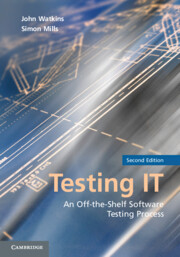Book contents
- Frontmatter
- Contents
- Foreword to the Second Edition by Geoff Thompson
- Foreword to the First Edition by Maurice Rosenburgh
- Acknowledgments
- 1 Introduction
- PART 1 THE TRADITIONAL TESTING PROCESS
- PART 2 THE TESTING PROCESS IN THE REAL WORLD: ILLUSTRATIVE CASE STUDIES
- PART 3 THE APPENDICES
- Appendix A Terms of Reference for Testing Staff
- Appendix B Testing Guides
- Appendix C Test Plan Document Template
- Appendix D Test Specification Document Template
- Appendix E Test Script Template
- Appendix F Test Result Record Form Template
- Appendix G Test Log Template
- Appendix H Test Certificate Template
- Appendix I Reuse Pack Checklist
- Appendix J Test Summary Report Template
- Appendix K Equivalence Partition Example
- Appendix L Boundary Value Analysis Example
- Appendix M State Transition Example
- Appendix N Pairwise Testing Example
- Appendix O Automated Testing Tool Selection Criteria
- Appendix P Usability Testing Overview
- Appendix Q Testing Process Health Check
- Appendix R The Testing of Object-Oriented Software
- Appendix S Pragmatic Test Process Adoption – a Real-World Example
- References
- Glossary
- Index
Appendix S - Pragmatic Test Process Adoption – a Real-World Example
Published online by Cambridge University Press: 03 May 2011
- Frontmatter
- Contents
- Foreword to the Second Edition by Geoff Thompson
- Foreword to the First Edition by Maurice Rosenburgh
- Acknowledgments
- 1 Introduction
- PART 1 THE TRADITIONAL TESTING PROCESS
- PART 2 THE TESTING PROCESS IN THE REAL WORLD: ILLUSTRATIVE CASE STUDIES
- PART 3 THE APPENDICES
- Appendix A Terms of Reference for Testing Staff
- Appendix B Testing Guides
- Appendix C Test Plan Document Template
- Appendix D Test Specification Document Template
- Appendix E Test Script Template
- Appendix F Test Result Record Form Template
- Appendix G Test Log Template
- Appendix H Test Certificate Template
- Appendix I Reuse Pack Checklist
- Appendix J Test Summary Report Template
- Appendix K Equivalence Partition Example
- Appendix L Boundary Value Analysis Example
- Appendix M State Transition Example
- Appendix N Pairwise Testing Example
- Appendix O Automated Testing Tool Selection Criteria
- Appendix P Usability Testing Overview
- Appendix Q Testing Process Health Check
- Appendix R The Testing of Object-Oriented Software
- Appendix S Pragmatic Test Process Adoption – a Real-World Example
- References
- Glossary
- Index
Summary
Introduction
It is often the case that test practitioners have been tasked with delivering quality improvements in their projects or organization, but do not have the luxury of sufficient time, resources, or budget to devise, design, implement, and roll out a fully formed and working testing process. This appendix provides a real-world example describing how it is still possible to adopt a subset of the best practices described in this book to gain immediate, “quick win,” quality improvements.
Test Process Adoption – a Real-World Example
Introduction
As a testing practitioner who has been tasked with improving the quality of the software delivered by your project or by your organization, where do you start the process of adopting and using quality management best practices?
What you have read so far may appear extremely virtuous, but if you do not have sufficient time, resource, or budget, it may appear to be too much change to bring about in too short a time. Grabbing a few users, with no plan and no goal, however busy everyone appears to be, is no substitute for deliberate acts of testing.
If you are able to recognize your predicament as being near the bottom of a waterfall development (69), with a delivery that is in danger of missing the deadline, your testing resource appears scant and the implementation date cannot be moved, then you are not alone!
- Type
- Chapter
- Information
- Testing ITAn Off-the-Shelf Software Testing Process, pp. 305 - 314Publisher: Cambridge University PressPrint publication year: 2010



